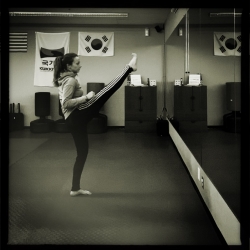
Don’t Skip The Stretching
Stretching is important for training in any sport. We all know the importance of it. As martial artists, we usually stretch before class. Stretching alone increases flexibility and range of motion. When possible, stretching with a partner – using his/her body weight – is an advanced way to get more work done in a shorter time. Stretching always should be pain-free. If there’s pain, then change position or use less force.
Here is a short routine you can do with a partner before or after a martial arts practice. Remember, this is not a competition! Work cooperatively, not competitively. Applying “the first awareness” approach is always a good idea. This technique, described in a book by Dr. Steven D. Stark “The Stark Reality of Stretching” (available on Amazon), encourages you to pause at the moment of “the first awareness”. After holding this position, there will be less tension and your body will be more comfortable in the assumed position. Then there’s time to reach a second awareness, where the stretch is deeper. The time you should hold the position varies for different people. Try to start with 5 deep breaths or a minute.
1. Assisted Neck Stretch

Sit straight on a massage table, bench, or crossed-legged on the floor. Your partner will be behind you. Try touching your chin to your chest until you feel a gentle stretch. Your partner will place one hand on the lower part of the back of your head and start pushing down. The other hand should be placed on your shoulder to stabilize it. Always remember to have a good posture. Our bodies tend to try to compensate, and you might not use the muscles that you want to stretch. Hold the stretch for 30-45 seconds. Take long deep breaths.
2. Assisted Arm Reach

Stay seated. Interlace your fingers, round your back, and reach your arms forward. The focus on this stretch is your upper back. Your partner will pull your arms forward. Remember not to hold your breath. When inhaling, expand your spine upward. Relax the shoulders while exhaling. Hold the stretch for 40 seconds to a minute.
3. Assisted Side Stretch

Still seated, raise one arm above your head. Bend to the side, trying to reach to the floor with the other arm. If you can’t reach the floor, don’t worry about it. Your partner will be behind you, holding your raised arm and helping you stretch by pulling gently. Pay attention to your posture. Your back should be straight to get the most of this stretch. Focus on your sides. Hold for 30 seconds to a minute and repeat on the other side.
4. Assisted Knee To Chest

Lay on the floor, legs straight. Bring one knee to your chest. Your partner will kneel in front of you. You can rest your foot on your partner’s shoulder, so you can use his/her body weight to get a better stretch. This is optional. To modify, your partner will place both hands right below your knee and start pushing. Hold this stretch for 30 seconds to a minute, and switch the legs.
5. Assisted Hamstring Stretch

Remain lying on the floor. This is very similar to the previous stretch. Lift one leg up. It should be straight. The other leg is straight on the floor. Do not bend it. Place your raised leg on your partner’s shoulder. Your partner will move forward and do most of the movement, so relax and let him/her stretch your hamstrings. Don’t forget to communicate how you feel during the exercise. Hold the stretch for 30 seconds to a minute and repeat with the other leg.
6. Assisted Seated Toe Touch

Sit on the floor, both legs straight. Maintain good posture and try to reach for your toes. This stretch is challenging, so don’t let your ego get in the way. If you cannot touch your toes with a straight back, modify by touching your ankles or your knees. A common mistake is to try to touch your knees with your head. Try to avoid this and focus on proper form. Your partner will kneel behind you, put both hands on your lower back, and gently push down, making sure your form is good. Hold this stretch for 30 seconds to a minute.
Happy Stretching!
This routine is quick but rewarding. Feel free to add more stretches and modify. Working with a partner is a great way to stretch deeper and get more flexible before class. You could try to have a longer partner stretch on your off day. Happy stretching!
Do you always stretch before class? If so, what is your go-to routine? Let me know in the comments below.
- Young Athletes and Martial Arts Injuries - November 11, 2020
- Martial Journal Spotlight: Anthony DelMar On Adults in Traditional Martial Arts - April 3, 2020
- Ankle Mobility Stretches for Martial Arts - February 24, 2020

There seems to be a bit of controversy these days re. stretching before a work out. The talking points are: 1. Stretching cold muscles increases chance of injury. 2. Long static stretches actually weaken muscles temporarily. Can you address these points?
Hi RoseAnne, thank you for bringing up valid arguments. Stretching without warm up is not recommended, although I did not mention that in the article. There are many different approaches and I’m writing from my experience. Before any martial art practice I personally need and enjoy a good stretch. Stretching without strengthening is never a good idea, this article is about partner stretching and its advantages, not about stretching in general. Thank you so much for an idea for the next article 🙂 Best, Anna
Thanks Anna – looking forward to reading more about this topic!